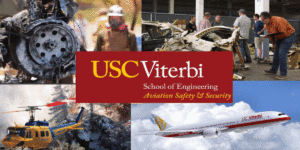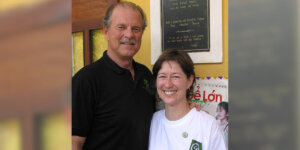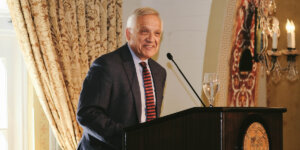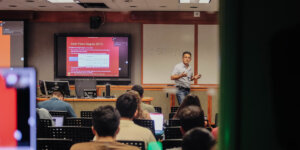
USC’s Aircraft Accident Investigation lab allows students to observe and examine the wreckage of real plane crashes to gain the real life experience in accident investigation. (Image Credit: Thomas Anthony)
When it comes to preventing aircraft hazards, crashes, and emergencies, the contributions of USC are among the most important in the nation. For over 60 years, USC professors have taught pilots, aircraft investigators, and aviation officials about why planes crash and how to prevent these failures through the USC Aviation Safety and Security Program. This program operates around the globe, teaching how to identify hazards in aircraft systems and take action to prevent them from manifesting into an accident.
The USC Aviation Safety and Security Program has recently extended aid to the World Food Program, an operation run by the United Nations where pilots fly in food, potable water, medical supplies, and other resources to regions in need, often in the wreckage of natural disasters like earthquakes, hurricanes, and flooding. Navigating landing in these regions is extremely difficult. Pilots often land on gravel airstrips or roads, sometimes packed with cattle or other obstacles.
“Each year, the World Food Program flies approximately 400,000 aid workers, peacekeepers, and others to regions all around the world,” said Dan Scalese, the automation and laboratory specialist for the Aviation Program. USC’s course trains these UN pilots on how to recognize, mitigate, communicate, and prevent hazards. In addition, USC’s training has helped numerous pilots working for different governments and companies around the world land safely in dangerous terrain and perilous conditions.
Just last November, a recent student of USC’s course, David Nordquist, who is a pilot for the Los Angeles Fire Department, successfully completed a dangerous rescue mission. While fighting the Woolsey Fire, he landed a plane in the Santa Monica Mountains, dealing with hazards including smoke, flames, and wind, then landing amidst communication towers and parked vehicles. Nordquist navigated a hazardous landing, ushered three people and two dogs fleeing from the fire aboard, and safely took off once again.
“We recognize the value of knowing what we teach here, so we try to give back,” said Tom Anthony, director of the USC Aviation Safety and Security Program. Anthony volunteers to give free training to World Food Program pilots and aircraft authorities.
Before Anthony began working for the Aviation Safety and Security Program, he worked for seven years in air traffic control and 18 years as an investigator for the Federal Aviation Administration. When he learned of USC’s program, he volunteered to teach at it, becoming a contract instructor. In 2007, after the position opened up, Anthony became the director of the program at USC.
The program’s Aircraft Accident Lab, located in an old warehouse in Los Angeles, is one of the best in the world. Amidst the twisted metal and wreckage of real crashed planes lies an opportunity for learning, where pilots can investigate what went wrong and learn how to prevent such mistakes in future flights.
“Our growing lab makes our program more attractive to investigation students from around the world,” Scalese said. “And finding new examples of plane crashes and learning their stories and what went wrong is always a treasure hunt.”
The Aviation Safety and Security Program has 45 instructors on staff. Classes are taught not only taught in the program’s classrooms in Los Angeles, but around the world. Many countries do not have training facilities that are designed to teach aircraft accident investigation, so USC’s program is immensely valuable to their pilots.
A wide variety of aviation organizations enroll in the program, from safety officers from major airlines in the United States to militaries, from civil aviation authorities to accident investigators from countries including Denmark, Mexico, Singapore, Chile, Namibia, and South Africa.
“Just this week we ran a course in Trinidad. The week before that, we taught in Tunisia,” Anthony said.
USC’s Aviation and Aircraft Safety and Security Program began in 1952 with a grant from the United States Air Force. At the time, the Air Force was experiencing too many crashes, losing too many planes and pilots and urgently wanted a program to increase air safety. The Safety Command at Norton Air Force Base in San Bernardino came to USC asking the university to research the root causes of aircraft accidents in the Air Force. The first USC class took place in 1953.
Although the program began by focusing on military aviation, it eventually extended to include civil aviation as well. During its first few decades, the program primarily focused on accidents and looking into their causes. Today, the program seeks a more proactive approach, aiming to identify and act upon hazardous activities and conditions before they result in accidents.
Mishaps that occur in aviation can usually be traced back to several related causal factors. To improve safety, the course teaches how to begin to identify all the links in the chain leading up to the mishap.
USC is also in the process of developing an app that could be used as a tool for pilots to teach them to identify and deal with possible hazards. The app is based on an acronym, PRIFISE, which stands for Plan; Roles; Intel; Fences, Gates, and Barriers; Identify Friend or Foe; Search or Screen; and Emergency Response. The acronym runs through the steps pilots should take when dealing with a dangerous situation in the air or while landing, preparing them for secure and safe trips in marginalized or dangerous regions of the world. The app will be used by pilots to assess risk, but also to quantify and record hazards.
“In the world of aviation safety, which is the whole world, this is the first aviation safety program that was established at a major research university,” Anthony said. “We continue to recognize the responsibility of that heritage and seek to be as current and effective in our contributions to aviation security as we can. It’s a big responsibility that we take seriously.”
Published on March 18th, 2019
Last updated on March 19th, 2019













